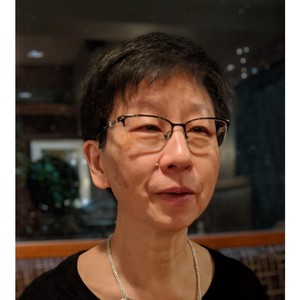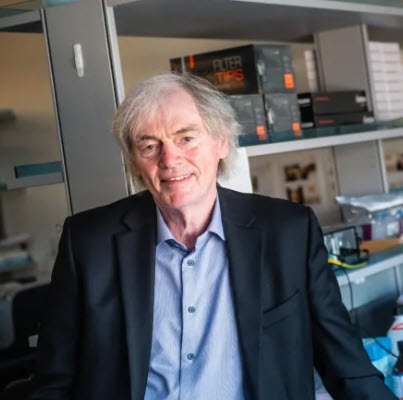BIOCAPS Spotlight: Bee Tan

BIOCAPS Spotlight: Bee Tan
Technician for Undergraduate Teaching Labs
BIOCAPS Spotlight is a new regular feature about people in BMB & CPS and their outstanding work. Meet faculty and staff members from across the Department of Biochemistry & Molecular Biology and the Department of Cellular & Physiological Sciences!
Bee Tan, our undergraduate teaching lab technician, has been the heart of our hands-on Biochemistry courses for 29 years.
Each year, around 200 students work and learn in our lab spaces. Bee’s work is crucial in the delivery of these practical courses efficiently, safely and reliably. Her meticulous planning, organization, and preparation are critical to our ability to offer valuable, advanced lab experiences and first-person learning for students. Beyond simply helping deliver our teaching content, Bee’s exceptional abilities as a research technician have been vital in ongoing development of new experimental procedures and lab projects.
Bee’s positive attitude, dedication and skill have been essential in our ability to offer high quality laboratory training and she is an invaluable part of the teaching team.
Tell us about your role as the Technician for Undergraduate Teaching Labs.
I manage and provide technical support to the two Biochemistry Undergraduate Teaching labs. In addition, I am involved in developing new teaching experiments for the fourth-year lab.
What does a typical day look like for you?
I usually start the day by organizing the student labs, setting up lab equipment and ensuring there are sufficient reagents for the students prior to start of the labs. I spend the rest of the day planning future experiments, ordering supplies, preparing reagents and carrying out prelab tests to validate reagents and experiments are working properly.
What is the favorite part about working for the Department of Biochemistry & Molecular Biology and UBC?
My favourite part about working for the department is the opportunity to continuously learn and grow.
Three words to best describe you
Organized, dependable and responsible.
Dr. Pieter Cullis named 2022 Canada Gairdner Award laureate
Award recognizes contributions to foundational technologies for the COVID-19 mRNA vaccines

Former LSI Director Dr. Pieter Cullis has been named a 2022 Canada Gairdner International Award laureate for his pioneering work developing the lipid nanoparticle delivery technology that enables mRNA therapeutics such as the highly effective COVID-19 mRNA vaccines.
The Gairdner Awards annually recognize scientists whose discoveries have had a major impact on biomedical and global health research. The highly prized accolade is known to foreshadow further recognition: Many of Gairdner laureates have gone on to receive the Nobel Prize.
Dr. Cullis was recognized April 5 alongside Dr. Katalin Karikó, senior vice president of RNA Protein Replacement Therapies at BioNTech SE and a professor at the University of Szeged and Dr. Drew Weissman, director of the Penn Institute for RNA Innovation at the University of Pennsylvania for their joint contributions to developing nucleoside-modified mRNA to avoid immunogenic reactions and improve the translational properties of mRNA once inside a cell.
“The work of Dr. Cullis and his esteemed colleagues enabled the rapid availability of highly effective and safe COVID-19 mRNA vaccines, which has been instrumental in protecting individuals during the pandemic,” says UBC President and Vice-Chancellor Santa J. Ono.
“We are extremely proud of Dr. Cullis’ enormous contributions to biomedical and global health research and congratulate him on this well-deserved honour.”
“On behalf of the Life Sciences Institute community, my sincere congratulations to Dr. Cullis, his amazing team, and his fellow Awardees on this much-deserved recognition,” says Dr. Josef Penninger, director of the LSI. “Not only has Dr. Cullis’ research contributed to saving millions of lives during the pandemic, his work has also revolutionized cancer treatment and gene therapies. He is an inspiration to us all. Dr. Cullis’ achievements shine a light on the amazing research done at the Life Sciences Institute, and I hope that this award marks the beginning of a new era of support for the life sciences at UBC and in BC: Investment in foundational research and that talent that drives it one day does pay off for society.”
Basic Science forms the foundation of COVID-19 mRNA vaccines
“It is an incredible honour to receive the Canada Gairdner International award,” says Dr. Cullis. “I am particularly honoured to receive it together with Drew Weissman and Katalin Karikó, who have done so much to make mRNA therapeutics a reality.”
The COVID-19 mRNA vaccines developed by Pfizer/BioNTech and Moderna are built on more than 30 years of established scientific research, including work carried out by Drs. Cullis, Karikó and Weissman. Drs. Karikó and Weissman discovered how to engineer mRNA—a molecule that carries instructions for making proteins—so that it could be used to produce the desired protein after introduction into human cells. Despite initial challenges and skepticism, they saw the potential of RNA for vaccines and other applications. However, one major challenge remained: how to introduce the mRNA into the body in a way that it would be protected from degradation and could enter cells for protein production.
A pioneer in lipid chemistry and the formation of lipid nanoparticles, Dr. Cullis had been working with delivery systems for the past 40 years. His foundational work has led to many clinical applications of lipid nanoparticles, such as delivering anticancer drugs to cancer tissues while limiting toxicity in normal tissues and advancing genetic therapies for rare diseases. In the case of mRNA, the lipid nanoparticles are designed to form a bubble around the mRNA that protects it from degradation and also enables uptake into cells and delivery of the mRNA into the cell cytoplasm. This technology is critical to the potency of mRNA vaccines.
‘Great research is a collective effort’
The long and winding road to the Pfizer/BioNTech COVID-19 vaccine has been one traveled with partners. The Gairdner Award, and the increasingly prestigious awards that preceded it are a recognition of group success, according to Dr. Cullis.
“It started from our interests in lipid polymorphism and lipid asymmetry. We were trying to understand why membrane lipids could adopt so many different structures as well as the consequences of having asymmetric trans-bilayer distributions of lipids in membranes,” says Dr. Cullis of his team when they began work on first-generation lipid nanoparticle drug delivery system. “Forty years ago, most of our interests were focused on quite basic science.”
Dr. Thomas Madden and Dr. Michael Hope have been Dr. Cullis’ close collaborators since the early 1980s. The trio, together with other UBC colleagues, targeted their first systems to deliver small molecule drugs used for chemotherapy. In 2009, they went on to launch UBC spin-off company Acuitas Therapeutics, now a highly successful biotech company based in Vancouver.
“Great research is a collective effort,” adds Dr. Cullis. “I would be remiss if I did not acknowledge the efforts of literally hundreds of people have helped make the COVID-19 mRNA vaccines possible. To have been part of this story is truly unbelievable and is a great example of how basic research is so essential to achieve new medicines that change the world.”
The success of the mRNA vaccines for COVID-19 suggest paths forward for similar vaccines for other viral threats, such as influenza or HIV. Clinical trials are already underway to test mRNA vaccines to prevent infections caused by Zika virus, chikungunya and rabies.
Pieter R. Cullis, Ph.D., FRSC, FNAI (USA), OC
Key Appointments
Founding Scientific Director and CEO, NanoMedicines Innovation Network (https://www.nanomedicines.ca)
Professor, Department of Biochemistry and Molecular Biology – UBC
Founding Scientific Director, Centre for Drug Research and Development (now AdMare)
Canadian Medical Research Council (MRC) Scholar (1978-1983)
MRC Scientist (1983-1988)
Awards & Honours
Dr. Cullis has published more than 360 studies, his inventions have led to more than 60 patents and his research has been cited more than 60,000 times.
Ayerst Award by the Canadian Biochemical Society in 1986
B.C. Science Council Gold Medal for Health Sciences in 1991
Alec D. Bangham Award for contributions to liposome science and technology in 2000
B.C. Biotechnology Association award for Innovation and Achievement in 2002
Elected a Fellow of the Royal Society of Canada in 2004
Barre award for contributions to Pharmaceutical Sciences by the University of Montreal in 2005
UBC Alumni Award for Research in Science and Medicine in 2005
Prix Galien Canada award 2011
Bill and Marilyn Webber Lifetime Achievement Award
Prince Mahidol Award 2021
Officer of the Order of Canada (2022)
VinFuture Prize 2022
This article originally appeared on the LSI Website and includes material from UBC Media Relations’ press release by Thandi Fletcher.